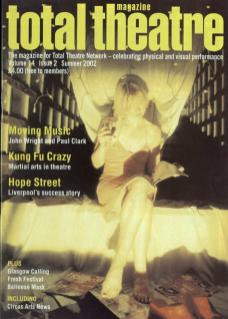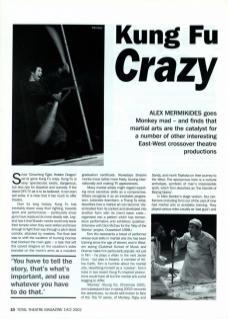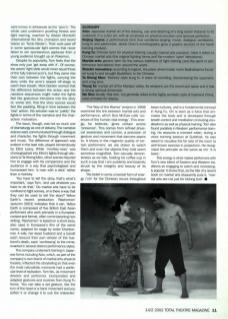Since Crouching Tiger, Hidden Dragon we've gone Kung Fu crazy. Kung Fu is sexy: spectacular, exotic, dangerous, but also ripe for slapstick and comedy. If the latest DFS TV ad is to be believed, it can even sell sofas. It is clear that it has much to offer theatre.
Over its long history, Kung Fu has inevitably drawn away from fighting, towards sport and performance – particularly since guns have replaced its more deadly role. Legend has it that Shaolin monks could only leave their temple when they were skilled and brave enough to fight their way through a pitch-black corridor, attacked by masters. The final test was to shift the cauldron of burning incense that blocked the main gate – a task that left the carved dragons on the cauldron's sides branded on the monk's arms as a macabre graduation certificate. Nowadays Shaolin monks move rather more freely, touring internationally and making TV appearances.
Many martial artists might regard exporting once secretive skills as a compromise. Others recognise it as an inevitable progression. Lokendra Arambam, a Thang Ta artist, describes how a martial art can become 'disembodied from its context and developed into another form with its [own] basic code... organised into a pattern which has tremendous performative and exhibitory qualities'. (Interview with Dick McCaw for the Way of the Warrior project, Dusseldorf 1998.)
Tom Wu represents a breed of performer whose dual skills in martial arts (he has been training since the age of eleven) and in Western acting (Guildhall School of Music and Drama) make him particularly popular, not just in film – he plays a villain in the next Jackie Chan – but also in theatre. A member of Yellow Earth, Tom is humble about his martial arts, describing himself as a 'cowboy'. Tom's roles in two recent Kung Fu inspired productions would have all but the martial arts purist begging to differ.
Monkey (Young Vic, Christmas 2001, and subsequent tour in spring 2002) recounts the adventures, no doubt well known to fans of the 70s TV series, of Monkey, Pigsy and Sandy, and monk Tripikata on their journey to the West. The eponymous hero is a cultural archetype, symbolic of man's irrepressible spirit, which Tom describes as 'the Hamlet of Beijing Opera'.
In Mick Gordon's stage version, four performers (including Tom) out of the cast of nine had martial arts or acrobatic training. They played various roles (usually as 'bad guys') and were known in rehearsals as the 'acros'. The whole cast underwent gruelling fitness and fight training, coached by Alistair Monteith (international Wu Shu champion and sword trainer on Tomb Raider). Their work paid off in some spectacular fight scenes that never failed to win spontaneous applause from a young audience brought up on Pokemon.
Despite its popularity, Tom feels that the show ‘only just got away with it'. Of course, the actors' fight skills would never equal those of the fully trained acros, but they came into their own between the fights, carrying the story while the acros sloped off-stage to catch their breath. Mick Gordon worried that the difference between the action and the narrative sequences might make the fights feel like gratuitous intrusions into the story or, worse still, that the story scenes would feel like padding, filling in time between the 'real' action. His solution was to justify the fights in terms of the narrative and the characters' motivation.
The issue, though, was not so much one of dramaturgy as one of delivery. The narrative scenes were communicated through dialogue and character, the fights through movement and music. The difference of approach was evident in the lead role, played tremendously by Elliot Leavy. While 'monkey-ness' was choreographed into Elliot's fights through allusions to Ta Sheng Men, other scenes required him to engage with his companions and the audience in a way that psychologised and humanised him: 'a man with a stick' rather than a monkey.
‘You have to tell the story, that's what's important,' says Tom, 'and use whatever you have to do that.' Do martial arts have to be confined to fight scenes, or is there a way that they can be used to tell the story? Yellow Earth's recent production Rashomon (autumn 2001) indicates that it can. Yellow Earth is composed of five British East Asian performers who work primarily in a European context and format, often commissioning new writing. Rashomon is based on a short story, also used in Kurosawa's film of the same name, adapted for stage by writer Charbonnier. A wife, her dead husband and a bandit each recount their own version of the husband's death, each 'confessing' to the crime, enacted in several distinct performance styles.
The company underwent training in Japanese forms including Aido, which, as part of the company's own brand of martial arts physical theatre, inflected the storytelling so that even the most naturalistic moments had a particular level of stylisation. Tom Wu, as movement director and performer, incorporated and adapted gestures and routines from Kung Fu forms. ‘You can take a set gesture, like the turn of the head or a hand movement and you soften it or change it to suit the character.'
The Way of the Warrior project in 1998 examined the link between martial arts and performance, which Dick McCaw calls 'sciences of the human vital energy'. This energy, he believes, gives certain actors presence. This comes from refined physical awareness and control, a precision of gesture and movement that dancers aspire to. It shows in the magnetic quality of certain performers: we are drawn to watch them and even the objects they hold seem somehow magnified. Tom casually demonstrates as we talk, holding his coffee cup in such a way that I am suddenly and bizarrely struck by the integrity and beauty of its shape.
The belief in some universal form of energy ('chi' for the Chinese) recurs throughout Asian cultures, and is a fundamental concept in Kung Fu. Chi is seen as a force that animates the body and is developed through breath control and meditation (including visualisation) as well as physical training. Tom also found parallels in Western performance training. He recounts a moment when, during a voice training session at Guildhall, he was asked to visualise the far side of the room (a well-known exercise in projection). He recognised the principle as the same as chi: 'It is basic.’
This energy is what makes performers with Tom's rare blend of Eastern and Western traditions so engaging to watch and increasingly popular. It shows that, as the title of a recent book on martial arts eloquently puts it, 'martial arts are not just for kicking butt'.
GLOSSARY
Aido: Japanese martial art of the drawing, use and returning of a long sword (Katana) to its scabbard. It is a Zen art, with an emphasis on physical precision and spiritual perfection.
Beijing Opera: a performance form that combines singing, music, dialogue, acrobatics, kung fu and pantomine. Jackie Chan's autobiography gives a graphic account of the harsh training involved.
Kung fu: Chinese term for physical training (usually martial arts practice). Here it refers to Chinese martial arts (the original fighting forms and the modern 'sport' derivations).
Martial arts: generic term for the various traditions of fight training (and the sport or performance derivations) from around the world.
Shaolin monastery: according to legend, the place where Indian monk Bodhidharma founded kung fu and brought Buddhism to the Chinese.
Ta Sheng Men: Monkey-style kung fu. It relies on tumbling, disorientating the opponent, and a big stick.
Thang Ta: martial art of the Manipur Valley. Its weapons are the sword and spear and it has a strong spiritual dimension.
Wu Shu: literally ‘War Arts', but generally refers to the highly acrobatic style of mainland China, used primarily for display.


